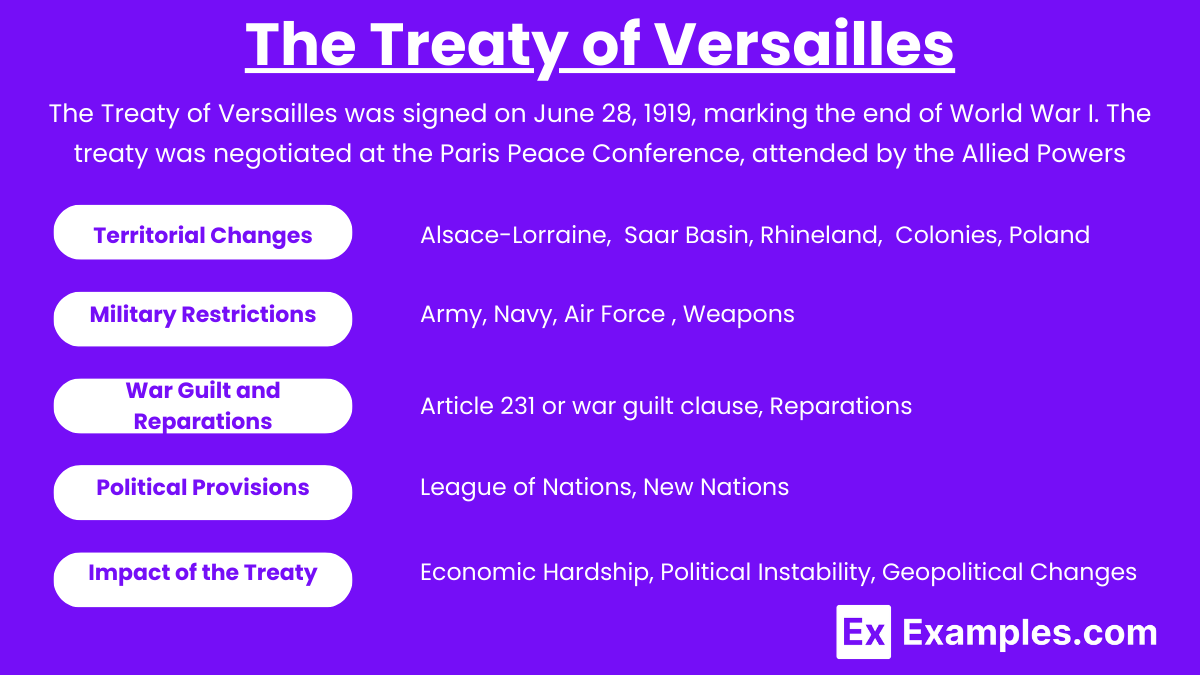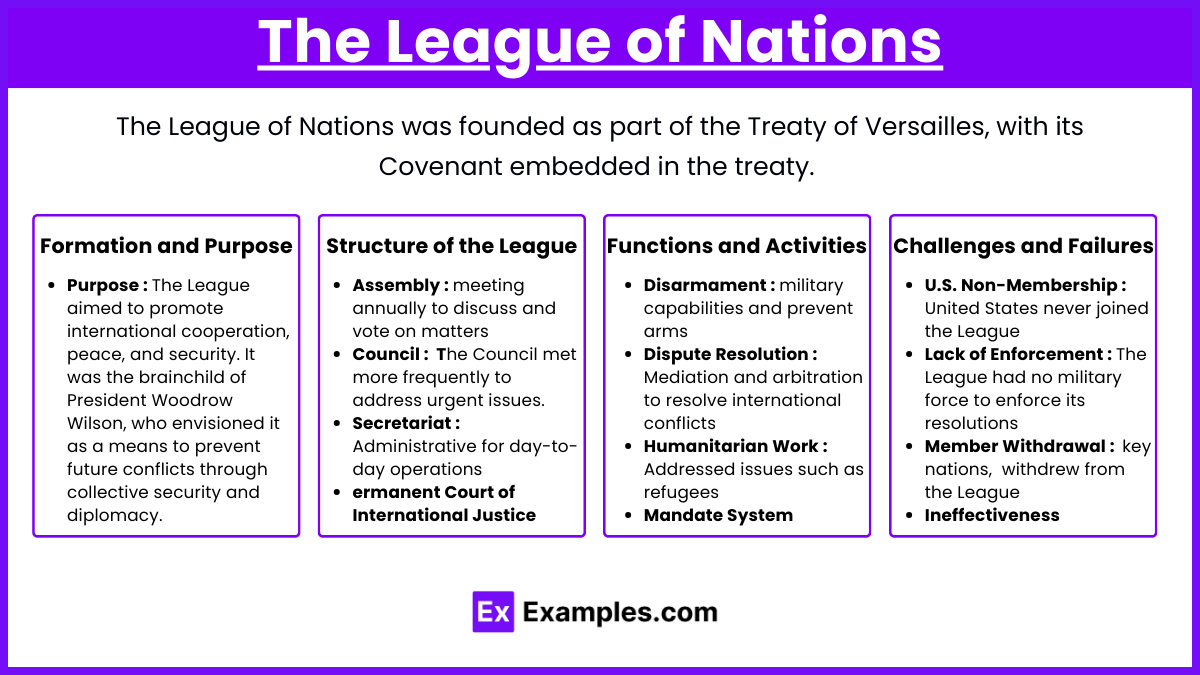
The Treaty of Versailles, signed in 1919, marked the end of World War I and imposed punitive measures on Germany, redrawing European borders and mandating reparations. It also led to the creation of the League of Nations, an international organization aimed at maintaining peace and preventing future conflicts. However, the treaty’s harsh terms contributed to economic hardship and political instability in Germany, key topics in AP European History, while the League faced challenges in enforcing its resolutions and ultimately failed to prevent the outbreak of World War II.
By studying the Treaty of Versailles and the League of Nations, you should understand the geopolitical and economic impacts of the treaty on post-WWI Europe, including territorial changes and reparations imposed on Germany. Learn the structure, aims, and weaknesses of the League of Nations, and how its inability to prevent further conflicts influenced global politics. Recognize the link between the treaty’s harsh terms and the rise of extremist movements, particularly in Germany, leading to WWII. Analyze the treaty’s long-term consequences for international relations and peacekeeping efforts.

The Treaty of Versailles was signed on June 28, 1919, marking the end of World War I. The treaty was negotiated at the Paris Peace Conference, attended by the Allied Powers, with significant influence from the “Big Four”: President Woodrow Wilson of the United States, Prime Minister David Lloyd George of Britain, Premier Georges Clemenceau of France, and Prime Minister Vittorio Orlando of Italy. The defeated Central Powers, including Germany, were not involved in the negotiations and were presented with the terms to accept.
The Treaty of Versailles contained several key provisions aimed at punishing Germany and preventing future conflicts:
The Treaty of Versailles had profound and lasting effects on Germany and Europe as a whole:

The League of Nations was founded as part of the Treaty of Versailles, with its Covenant embedded in the treaty. The League aimed to promote international cooperation, peace, and security. It was the brainchild of President Woodrow Wilson, who envisioned it as a means to prevent future conflicts through collective security and diplomacy.
The League of Nations had several key components:
The League of Nations undertook various activities to maintain peace and promote cooperation:
Despite its noble aims, the League of Nations faced significant challenges and shortcomings:
The Treaty of Versailles and the League of Nations were pivotal in shaping the post-World War I world order. The treaty’s harsh terms on Germany sowed the seeds of future conflict, while the League’s innovative but flawed approach to international cooperation highlighted the complexities of achieving lasting peace. Together, they offer essential lessons on the challenges of diplomacy and the quest for global stability.
The Treaty of Versailles, signed in 1919, included the Covenant of the League of Nations. This was the first international organization aimed at maintaining world peace and preventing future conflicts. It was a significant step towards global cooperation and collective security.
One of the most controversial provisions of the Treaty of Versailles was the “War Guilt Clause,” which placed full responsibility for World War I on Germany. This clause not only humiliated Germany but also justified the reparations imposed on the country. The League of Nations was supposed to oversee the enforcement of these reparations and ensure compliance.
The Treaty of Versailles established the mandate system, which placed former German and Ottoman territories under the administration of the League of Nations. These mandates were distributed among the victorious Allied powers. The goal was to prepare these territories for self-governance, although in practice, they often became colonies in all but name.
The League of Nations, established by the Treaty of Versailles, aimed to promote disarmament and prevent military build-ups that could lead to another war. While the League made several attempts to negotiate arms reduction, these efforts largely failed due to lack of enforcement mechanisms and the unwillingness of major powers to disarm.
The League of Nations provided a platform for arbitration and resolution of international disputes. For instance, in the 1920s, the League successfully mediated conflicts such as the dispute between Greece and Bulgaria and the border conflict between Finland and Sweden over the Åland Islands. These actions were direct implementations of the peacekeeping intentions outlined in the Treaty of Versailles.
What was one of the main goals of the Treaty of Versailles?
A. To establish a military alliance between the Allied Powers
B. To punish Germany and prevent future wars
C. To promote free trade among European nations
D. To create a new global currency
Answer: B. To punish Germany and prevent future wars
Explanation: The Treaty of Versailles aimed to ensure that Germany would be held responsible for World War I. It imposed heavy reparations on Germany, limited its military capabilities, and took away significant territories. The treaty’s primary goal was to punish Germany and create conditions that would prevent it from becoming a threat in the future, thereby promoting long-term peace in Europe.
Which of the following was a major reason for the United States Senate’s refusal to ratify the Treaty of Versailles?
A. Opposition to the League of Nations
B. Desire to annex German territories
C. Belief that the treaty was too lenient on Germany
D. Disagreement with the reparation payments
Answer: A. Opposition to the League of Nations
Explanation: The U.S. Senate refused to ratify the Treaty of Versailles primarily because of concerns regarding the League of Nations. Many senators, particularly the isolationists, believed that joining the League would entangle the United States in future international conflicts and infringe on its sovereignty. They were wary of the mutual defense obligations that the League of Nations might impose, which led to the rejection of the treaty.
What role did the League of Nations play in the aftermath of World War I?
A. It successfully prevented all future wars
B. It facilitated international cooperation and conflict resolution
C. It created a single global government
D. It reorganized Europe’s political boundaries
Answer: B. It facilitated international cooperation and conflict resolution
Explanation: The League of Nations was established to promote international cooperation and to provide a platform for resolving disputes peacefully. Although it had some successes in mediating conflicts and managing international issues, it struggled with significant limitations, such as the absence of key powers like the United States and the lack of a military force to enforce its resolutions. Despite these challenges, the League laid the groundwork for future international organizations aimed at maintaining global peace and security.
Free Interactive Teacher Resources